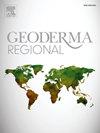Origin and rupture of a podzolized pedological system in the dissected coastal tablelands of the North coast of the state of Bahia
IF 3.3
2区 农林科学
Q2 SOIL SCIENCE
引用次数: 0
Abstract
The North Coast of the State of Bahia is known for having a diversity of ecosystems and landscapes. However, these ecosystems, located on dunes, marine terraces and coastal tablelands, are very fragile and targeted by tourist developments in the region, making them even more vulnerable to environmental degradation. This fragility comes mainly from the sandy geomorphological surfaces and features, covered by pioneer plant formations. Research in the Coastal Tablelands has shown that the origin of sandy soils with low fertility and high erodibility, especially the Spodosols, is the result of a podzolization process of the lateritic soils in the Coastal Tablelands. However, there are areas where podzolization may have occurred in allochthonous and previously sandy surface formations, such as eolian and fluvial deposits. In addition, the dissection of the Coastal Tablelands has eroded the podzolized surfaces and exposed the Barreiras Formation facies that form soils as fragile as the Spodosols - the Inceptisols. Thus, the aim of this research was to characterize and identify the origin of a Quartzipsamment - Spodosol pedological transformation system, interrupted by a low-slope Inceptisols, in an area of Dissected Coastal Tablelands on the North Coast of Bahia. The construction of a toposequence, combined with geophysical studies and the collection of morphological, chemical and physical soil data, as well as fourier transform infrared (FTIR) analysis of the samples collected, produced data that supported discussions and interpretations on the pedogeomorphological evolution of the slope studied. Thus, the results indicated that the podzolization process occurred in allochthonous sandy deposits, given the high vertical lithological discontinuity presented in the profiles of the upper slope sector of the toposequence. On the other hand, the Quartzipsamment and Spodosol of this sector showed lateral links and a break with the low slope sector which, from the incision of the Coastal Tablelands, formed the Inceptisol on the lower slope over underlying facies of the Barreiras Formation.
巴伊亚州北部海岸高原上灰化土化土壤系统的起源和断裂
巴伊亚州北海岸以生态系统和景观的多样性而闻名。然而,这些位于沙丘、海洋阶地和沿海台地上的生态系统非常脆弱,是该地区旅游开发的目标,使其更容易受到环境退化的影响。这种脆弱性主要来自被先锋植物群落覆盖的沙质地貌表面和特征。沿海台地的研究表明,肥力低、侵蚀性强的沙质土壤,尤其是 Spodosols,是沿海台地红土荚果化过程的结果。不过,在一些地区,同生土和以前的沙质表层构造(如风化沉积物和河流沉积物)中也可能发生了豆荚状砾石化。此外,海岸台地的剖面侵蚀了豆荚砾石化的地表,暴露出巴雷拉斯地层,形成了与 Spodosols 一样脆弱的土壤--Inceptisols。因此,这项研究的目的是描述和确定巴伊亚州北海岸断裂海岸台地地区被低坡度 Inceptisols 所阻断的石英淀粉--旋积土土壤学转换系统的起源。通过构建地形序列,结合地球物理研究,收集土壤形态、化学和物理数据,以及对收集的样本进行傅立叶变换红外分析,得出的数据支持了对所研究斜坡的植被地貌演变的讨论和解释。因此,研究结果表明,由于地形序列上部斜坡剖面呈现出高度垂直的岩性不连续性,因此豆荚砾石化过程发生在同生砂质沉积物中。另一方面,该地段的石英砂岩和 Spodosol 显示出与低坡地段的横向联系和断裂,低坡地段由于海岸台地的侵蚀,在巴雷拉斯地层的底层上形成了下坡的 Inceptisol。
本文章由计算机程序翻译,如有差异,请以英文原文为准。
求助全文
约1分钟内获得全文
求助全文
来源期刊

Geoderma Regional
Agricultural and Biological Sciences-Soil Science
CiteScore
6.10
自引率
7.30%
发文量
122
审稿时长
76 days
期刊介绍:
Global issues require studies and solutions on national and regional levels. Geoderma Regional focuses on studies that increase understanding and advance our scientific knowledge of soils in all regions of the world. The journal embraces every aspect of soil science and welcomes reviews of regional progress.
 求助内容:
求助内容: 应助结果提醒方式:
应助结果提醒方式:


